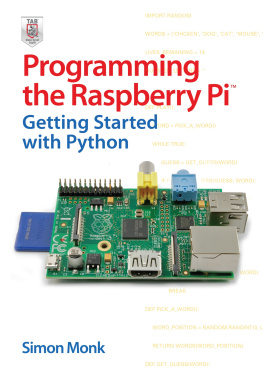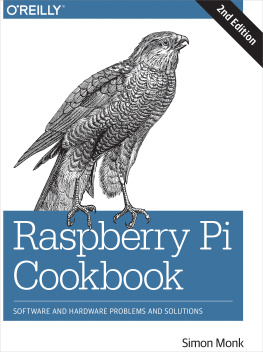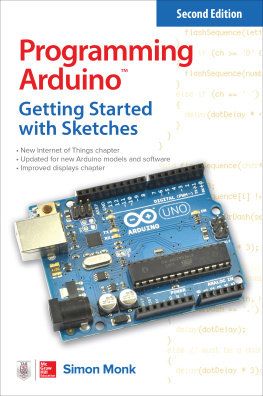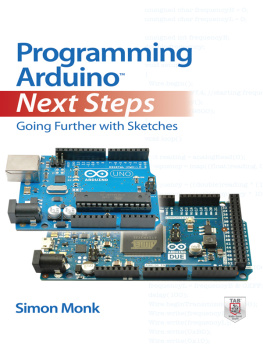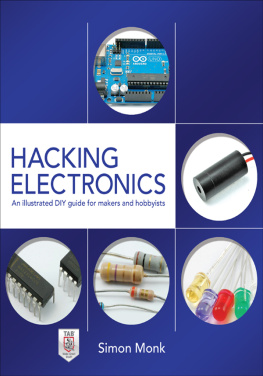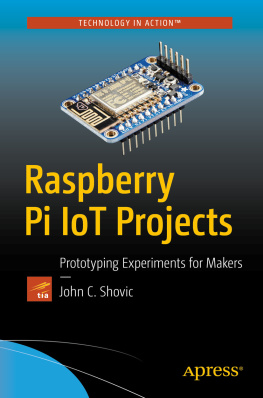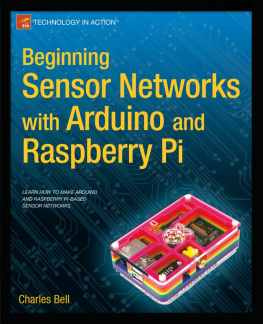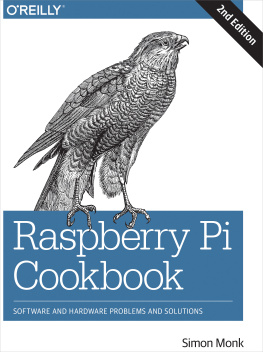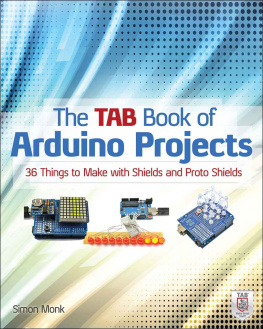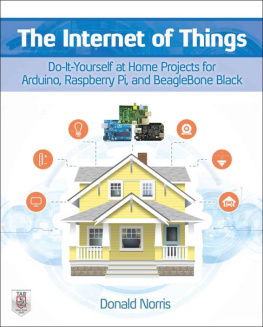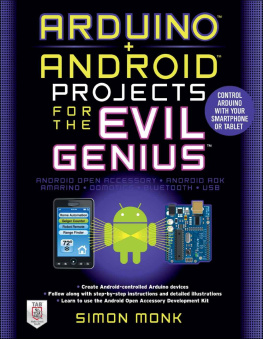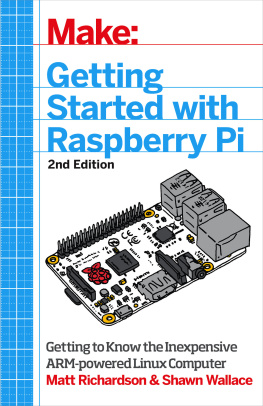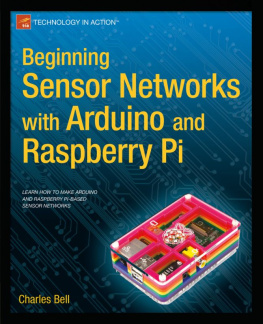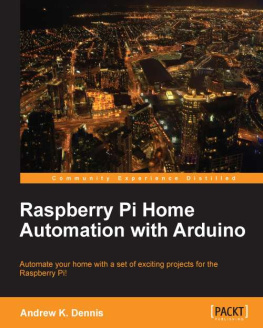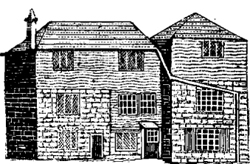THE MAKERS GUIDE TO THE ZOMBIE APOCALYPSE
DEFEND YOUR BASE WITH SIMPLE CIRCUITS, ARDUINO, AND RASPBERRY PI
SIMON MONK
NO STARCH PRESS SAN FRANCISCO
THE MAKERS GUIDE TO THE ZOMBIE APOCALYPSE. Copyright 2016 by Simon Monk.
All rights reserved. No part of this work may be reproduced or transmitted in any form or by any means, electronic or mechanical, including photocopying, recording, or by any information storage or retrieval system, without the prior written permission of the copyright owner and the publisher.
Printed in USA
First printing
19 18 17 16 15 1 2 3 4 5 6 7 8 9
ISBN-10: 1-59327-667-2
ISBN-13: 978-1-59327-667-6
Publisher: William Pollock
Production Editor: Serena Yang
Cover and Interior Design: Beth Middleworth
Illustrator: Miran Lipovaa
Developmental Editor: Jennifer Griffith-Delgado
Copyeditor: Paula L. Fleming
Compositor: Serena Yang
Proofreader: James Fraleigh
Indexer: BIM Indexing & Proofreading Services
For information on distribution, translations, or bulk sales, please contact No Starch Press, Inc. directly:
No Starch Press, Inc.
245 8th Street, San Francisco, CA 94103
phone: 415.863.9900;
www.nostarch.com
Library of Congress Cataloging-in-Publication Data
Monk, Simon, author.
The makers guide to the zombie apocalypse : defend your base with simple circuits, Arduino, and Raspberry Pi / by Simon Monk.
pages cm
Includes index.
Summary: "A collection of DIY hardware projects using circuits, Arduino, and Raspberry Pi to store electricity, detect invading zombies, generate solar power, and create communication and surveillance devices. Projects include alarms, low-power LED lighting, an FM radio frequency hopper, a periscope, a wind turbine, and flash, movement, and noise makers"--Provided by publisher.
ISBN 978-1-59327-667-6 -- ISBN 1-59327-667-2
1. Electronic apparatus and appliances--Design and construction--Amateurs manuals. 2. Microcontrollers--Amateurs manuals. 3. Electronic circuits--Amateurs manuals. 4. Arduino (Programmable controller)--Amateurs manuals. 5. Raspberry Pi (Computer)--Amateurs manuals. I. Title.
TK9965.M673 2015
621.381--dc23
2015023925
No Starch Press and the No Starch Press logo are registered trademarks of No Starch Press, Inc. Other product and company names mentioned herein may be the trademarks of their respective owners. Rather than use a trademark symbol with every occurrence of a trademarked name, we are using the names only in an editorial fashion and to the benefit of the trademark owner, with no intention of infringement of the trademark.
The information in this book is distributed on an As Is basis, without warranty. While every precaution has been taken in the preparation of this work, neither the author nor No Starch Press, Inc. shall have any liability to any person or entity with respect to any loss or damage caused or alleged to be caused directly or indirectly by the information contained in it.
To Jonathan and Michaela
on your wedding.
May you have a wonderful
and zombie-free life together.
ABOUT THE AUTHOR
Simon Monk is a full-time author and maker, mostly writing about electronics for makers. Some of his better-known books include Programming Arduino: Getting Started with Sketches, Raspberry Pi Cookbook, and Hacking Electronics. He is also the co-author of Practical Electronics for Inventors and wrote Minecraft Mastery with his son, Matthew Monk.
Simon also writes for MagPi magazine and helps out with Monk Makes (http://www.monkmakes.com/), a company run by his wife Linda, which makes and sells component kits and other products related to Simons books. You can follow Simon on Twitter where he is @simonmonk2 and find out more about his books at http://www.simonmonk.org/.
ABOUT THE TECHNICAL REVIEWER
Jeremy Blum is a Hardware Astronaut at Google, where he focuses on electrical design and advanced prototyping for future Google hardware. Jeremy received both a bachelors degree and a masters degree in electrical and computer engineering from Cornell University, and was selected by the American Institute of Electrical and Electronics Engineers as the 2012 New Face of Engineering.
Jeremys popular Arduino tutorial videos and his book, Exploring Arduino, have introduced millions of people around the world to engineering. He offers engineering consulting services through his firm, Blum Idea Labs LLC, and he frequently teaches engineering courses to young students and adults across the United States. Jeremys passion is improving peoples lives and our planet through creative engineering solutions; you can learn more about him and his work at http://www.jeremyblum.com/.
CONTENTS IN DETAIL
ACKNOWLEDGMENTS
Many thanks to the enthusiastic and dedicated team at No Starch Press, especially to my thorough and patient editors Jennifer Griffith-Delgado and Serena Yang, who have guided this project from initial idea to finished book with skill and imagination.
I would especially like to thank Miran Lipovaa for his wonderful illustrations that add so much to the book and Jeremy Blum for his technical review of the material. I am very honored to have two such noteworthy individuals involved in the project.
Finally I would like to thank Linda (see ) for her patience and understanding during the writing of this book.
INTRODUCTION
This is a book for people who like to make things but also enjoy the premise of a postapocalypse world where you cannot assume a limitless supply of electricity and other resources. As such, book starts with projects for generating electricity through solar and pedal-power (using a scavenged car alternator). Once you have power, youll move on to surveillance and monitoring projects that will help you protect your base. Finally, youll build communication projects that allow you to find other survivors and even send messages to members of your group via silent haptic communication.
KEY MAKER SURVIVAL SKILLS
Some projects in this book require no more technical skill than being able to attach a wire to a screw terminal, while others require you to be able to will get you started on any technical skills that may be new to you. A few of the projects also require some basic wood-working skills and tools, but you wont need anything more fancy than a saw, drill, and chisel.
The more technical projects in the book make use of the popular Raspberry Pi and Arduino as low power easy to use control modules. See for a primer on the Arduino.



